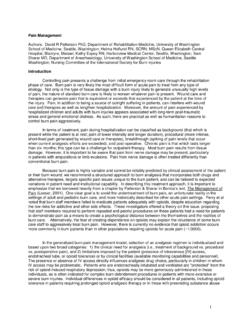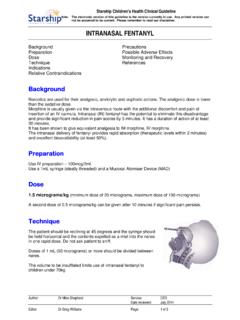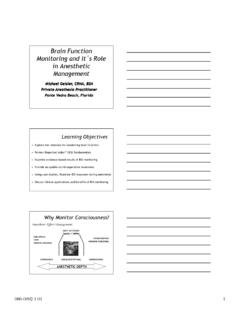Transcription of Key Points - WHO
1 ESSENTIAL HEALTH TECHNOLOGIESCLINICAL PROCEDURESHTP/EHT/CPR14 practical anaesthesiaPractical anaesthesiaKey PointsESSENTIAL HEALTH TECHNOLOGIESCLINICAL PROCEDURESHTP/ ANAESTHESIAGENERAL ANAESTHESIA Have a clear plan before starting anaesthesia Never use an unfamiliar anaesthetic technique in an emergency Always check your equipment Make sure you have an assistant before starting Ensure that that you have the correct patient for the correct surgery on the correct HEALTH TECHNOLOGIESCLINICAL PROCEDURESHTP/ GENERAL ANAESTHESIA Always begin your anaesthetic with the patient lying on a table that can be rapidly tilted into a head down position in case of sudden hypotension or vomiting Your choice of an anaesthetic technique, especially in an emergency, should be the one with which you are most experienced and confidentESSENTIAL HEALTH TECHNOLOGIESCLINICAL PROCEDURESHTP/ GENERAL ANAESTHESIA General anaesthesia with intubation and controlled ventilation is effectively a universal technique.
2 Although relatively time-consuming for short cases, there is almost no procedure for which it is unsuitable Oxygen cylinders must be checked to see that they are full and connections fit the breathing systemESSENTIAL HEALTH TECHNOLOGIESCLINICAL PROCEDURESHTP/ GENERAL ANAESTHESIA contd. Cricoid oeasophageal compression should always be applied until the endotracheal tube is inflated Where there is no designated recovery room, make sure that the patient is awake, breathing and stable before leaving the operating room ESSENTIAL HEALTH TECHNOLOGIESCLINICAL PROCEDURESHTP/ ANAESTHESIAGENERAL ANAESTHESIAESSENTIAL HEALTH TECHNOLOGIESCLINICAL PROCEDURESHTP/EHT/CPR If you plan to intubate.
3 Always have a backup plan in case of failure do not persist with multiple attempts just to prove that you can do it do not make your ability to intubate more important than the patient's life Give extra oxygen before and after the end of the anaesthetic . Continue to monitor the patient just as carefully after you haveturned the anaesthetic off until the patient is fully awake A blocked tracheal tube = a dead ANAESTHESIAGENERAL ANAESTHESIAESSENTIAL HEALTH TECHNOLOGIESCLINICAL PROCEDURESHTP/ GENERAL ANAESTHESIAV omiting and regurgitation Seeing stomach contents in the unprotected airway of an unconscious patient is probably the worst thing that can happen in the practice of anaesthesia.
4 Do not let this happen to HEALTH TECHNOLOGIESCLINICAL PROCEDURESHTP/ DURING PREGNANCY ANAESTHESIA DURING PREGNANCY AND FOR OPERATIVE DELIVERYAND FOR OPERATIVE DELIVERY If using general anaesthesia in an eclampticpatient, there may be a huge rise in blood pressure at intubation Prevent this with a bolus of 2 3 G magnesium sulfate before intubation. If the mother and child are both critically ill, it is your clear duty to attend to the mother firstESSENTIAL HEALTH TECHNOLOGIESCLINICAL PROCEDURESHTP/ ANAESTHESIA DURING PREGNANCY AND FOR OPERATIVE DELIVERY Place a pillow under one hip to tilt the uterus to avoid supine hypotension Don t be so concerned about the baby that you fail to give the mother a sufficient dose of anaesthetic.
5 At the end of anaesthesia: remember that the mother has a full stomach, remove the endotrachael tube with her in the lateral positionESSENTIAL HEALTH TECHNOLOGIESCLINICAL PROCEDURESHTP/ ANAESTHESIAPEDIATRIC ANAESTHESIA For children under 15 kg, differences in anatomy and physiology mean you will have to significantly modify your anaesthetic technique Pay special attention to fluid and heat losses in HEALTH TECHNOLOGIESCLINICAL PROCEDURESHTP/ PEDIATRIC ANAESTHESIA As a rough guide for normally nourished children more than about 2 years old, use the following formula to calculate the internal diameter of the tubelikely to be of the correct size: Internal diameter of tube (mm) = (age in years + ) 4 ESSENTIAL HEALTH TECHNOLOGIESCLINICAL PROCEDURESHTP/ PEDIATRIC ANAESTHESIA Rough indicators of the correct size of tubeare.
6 Diameter the same as the child s little finger Most neonates will need a tube of 3 mm internal diameter For premature infants, a mm tube may be necessary To estimate the length of tube needed, double the distance from the corner of the child s mouth to the ear canal To check, look at the child s head from the side while holding the upper end of the tube level with the mouth to give you an idea of how far into the chest the tube will HEALTH TECHNOLOGIESCLINICAL PROCEDURESHTP/ PEDIATRIC ANAESTHESIA Do not attempt to put up an intravenous infusion while the child is awake as this will cause deterioration especially in children with laryngo-tracheitis Do not send a child in respiratory distress to X-ray department.
7 Urgent management is neededESSENTIAL HEALTH TECHNOLOGIESCLINICAL PROCEDURESHTP/ PEDIATRIC ANAESTHESIAP aediatric Elective Anaesthesia Continuous monitoring of heart rate and respiration is essential in small children. A precordial or oesophageal stethoscope is invaluable for HEALTH TECHNOLOGIESCLINICAL PROCEDURESHTP/ PEDIATRIC ANAESTHESIAP aediatric Emergency Anaesthesia Do not attempt to put up an intravenous infusion while the child is awake as this will cause deterioration especially in children with laryngo-tracheitis Do not send a child in respiratory distress to the X-ray department. Urgent management is needed. Ensure that the nurses understand the need to prevent the tube becoming blocked with dried secretionsESSENTIAL HEALTH TECHNOLOGIESCLINICAL PROCEDURESHTP/ CONDUCTION ANAESTHESIA All local anaesthetic drugs.
8 Are potentially toxic May depress the central nervous system May cause drowsiness, which may progress to unconsciousness with twitching and possibly convulsions May cause hypotension related either to extensive sympathetic blockade, ( after high spinal anaesthesia) or to direct depression of cardiac function from high blood levels of the HEALTH TECHNOLOGIESCLINICAL PROCEDURESHTP/ ANAESTHESIACONDUCTION ANAESTHESIAT oxicity And Safety Of Local Anaesthetic Drugs Local anaesthetic drugs can be toxic you must know the maximum safe dose If a severe toxic reaction occurs, prompt resuscitation is needed Avoid toxicity by using the most dilute solution that will do the job.
9 Lidocaine or bupivacaine for most nerve blocks- lidocaine or pilocaine for simple HEALTH TECHNOLOGIESCLINICAL PROCEDURESHTP/ CONDUCTION ANAESTHESIAT oxicity And Safety Of Local Anaesthetic Drugs The rate of absorption of the drug can also be reduced by injecting it together with a vasoconstrictor drug, such as: epinephrine, which is most often used in a dilution of 5 mg/ml (1:200 000); for infiltration, mg/ml (1:400 000) is enough. Pre-mixed ampoules of local anaesthetic and epinephrine are often available but, if they are not, you can easily mix your own. To make a 1:200000 dilution of epinephrine (adrenaline): add ml of 1:1000 epinephrine to 20 ml of local anaesthetic HEALTH TECHNOLOGIESCLINICAL PROCEDURESHTP/ CONDUCTION ANAESTHESIAS edation during conduction anaesthesia Never give sedation to cover an inadequate nerve block Do not let sedation drift into unconsciousness with an uncontrolled airway.
10 A sedated patient should still be able to talk to youESSENTIAL HEALTH TECHNOLOGIESCLINICAL PROCEDURESHTP/ CONDUCTION ANAESTHESIASPINAL ANAESTHESIA Check all equipment and drugs as for general anaesthesia In a pregnant women at term, the block very easily goes high Always give oxygen to the mother during caesarean section Act immediately to treat the unresponsive patient, whether the cause is hypotension or high spinal A death or complication after spinal is usually due to neglect of vital signsESSENTIAL HEALTH TECHNOLOGIESCLINICAL PROCEDURESHTP/ CONDUCTION ANAESTHESIASPINAL ANAESTHESIA Avoid spinal anaesthesia in: patients in shock who are not fully resuscitated infection at the site of the spinal needle placement frank coagulopathy patient refusal convulsion, raised intracranial pressure due to brain tumour Use a thin 25 gauge spinal needle ESSENTIAL HEALTH TECHNOLOGIESCLINICAL PROCEDURESHTP/ ANAESTHETIC TECHNIQUESSPECIMIN ANAESTHETIC TECHNIQUESK etamine Anaesthesia Ketamine is a full general anaesthetic.














